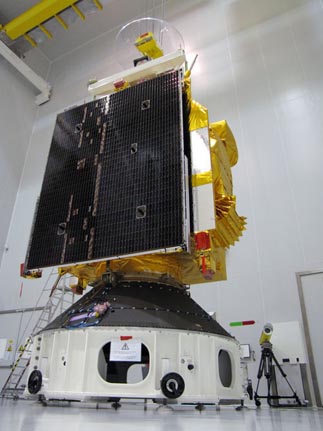Geostationary satellite by Korea reaches orbit
Published: 27 Jun. 2010, 22:22

Korea’s first geostationary satellite, the Chollian. [NEWSIS]
The Korea Aerospace Research Institute (KARI) and the Ministry of Education, Science and Technology said an Ariane 5-ECA rocket carrying the Korean satellite, which is named Chollian, successfully launched at 6:41 a.m. Korean time after being delayed several times on Thursday and Friday by minor technical problems.
The satellite successfully reached geostationary transfer orbit and separated from the second stage rocket 32 minutes and 38 seconds after lift-off and at an altitude of 2,005.3 kilometers (1,246 miles), the ministry said. At 7:19 a.m., or 38 minutes after the launch, the Dongara ground station in Australia established first contact with the satellite.
“The satellite’s position and its electrical on-board equipment and temperature were found to be normal,” said Ryu Guk-hee, an aerospace development director of the ministry.
The satellite still needs to use booster rockets to reach its ultimate orbital attitude of 36,000 kilometers in the next eight days and deploy solar panels to be able to function.
The satellite was developed and built by the Electronics and Telecommunications Research Institute (ETRI), KARI and Korean Ocean Research and Development Institute in partnership with France-based EADS Astrium. It cost 345.8 billion won ($284.1 million) and took nine years and seven months to build.
The satellite is to carry out three different missions - meteorology applications, ocean monitoring and telecommunications - over the Korean Peninsula at an altitude of 36,000 kilometers. It has an expected life of 7.7 years. Currently, Korea relies on foreign satellites for its weather information, getting the data every 30 minutes from Japanese ones and less frequently from a U.S. satellite. However, when the Chollian starts operation, it will send weather information every 15 minutes in and every eight minutes in times of emergency such as typhoons.
The satellite makes Korea the seventh country in the world to have its own weather satellite, and the 10th nation to develop a geostationary satellite, according to the ministry. Korea also becomes the world’s first to operate a geostationary ocean satellite. The previous satellites Korea sent to orbit were not geostationary.
The satellite will start operating in December.
By Shim Jae-woo, Limb Jae-un [jbiz91@joongang.co.kr]










with the Korea JoongAng Daily
To write comments, please log in to one of the accounts.
Standards Board Policy (0/250자)